The Friends of the Wildflower Garden, Inc.
Plants of the Eloise Butler Wildflower Garden
The oldest public wildflower garden in the United States
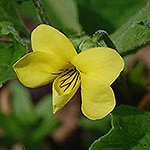
Common Name
Downy Yellow Violet (Yellow Violet, Yellow Forest Violet)
Scientific Name
Viola pubescens Aiton
Plant Family
Violet (Violaceae)
Garden Location
Woodland
Prime Season
Spring Flowering
Downy Yellow Violet is a native erect perennial forb of the dry woods, growing up to 18 inches high, but usually much shorter, on leafy stems that have soft velvety hair - more so when young.
Leaves are both basal and on the stem. Basal leaves are long stalked, number 1 to several and with a more rounded shape than the stem leaves. Stem leaves are near the top of the stem and usually number 2 to 4. These are broadly heart-shaped to kidney shaped and larger ones may have lobes near the base. Tips are pointed. Both the basal and the stem leaves have margins with rounded teeth and both have heart-shaped bases. The stem leaves have a rather large pair of stipules at the base of the short leaf stalk. The stipules are ovate in shape with entire margins or just a few coarse teeth. The underside of the leaves is hairy and has prominent leaf veins.
The inflorescence is a solitary flower on a long stalk rising from the upper leaf axils.
The flowers of the Violet family are are two types. Those that form an open flower are called "chasmogamous" (open marriage) and those that never open are called "cleistogamous" (closed marriage). Both types are bisexual (perfect) and set seed but at different times.
The chasmogamous flower is 5-parted with a yellow corolla, averaging 3/4 to 1 1/4 inches wide with each petal (less-so on two upper) having brownish-purple veins showing (nectar guides for insects to reach the nectar spur at the back of the flower). The two side petals are bearded. There are 5 stamens with thin short filaments. Each stamen has a dorsal appendage and the five appendages cohere tightly to form a hollow cone around the central section of the single style. The flower stem has soft hairs. The 5 green sepals of the calyx are narrow and pointed. These flowers open and set seed in the Spring from mid-April to May. A certain percentage can self pollinate.
The cleistogamous flowers are not produced until after the tree canopy is leafed out - May to September. They are smaller and appear to be flower buds in the leaf axils. In most violets the cleistogamous flowers produce the abundance of seed, but not in V. pubescens; here the open flowers are twice as productive in seed production.
Seed: Seeds from both types of flower are similar and are in an ovoid 3-part capsule, sometimes hairy, that contains numerous dull white to pale brown ellipsoid shaped seeds, each 1.8 - 3 mm long, which are ejected when the capsule matures. Viola seeds usually require 60 days of cold stratification plus light for germination.
For details on the flower and seed development see:
(1) Culley T.M. (2002) Reproductive biology and delayed selfing in Viola pubescens
(Violaceae), an understory herb with chasmogamous and cleistogamous flowers.
International Journal of Plant Sciences, 163, 113-122.
(2) Yunjing Wang (2008). Molecular biology of flower development in Viola pubescens, a species with the chasmogamous - cleistogamous mixed breeding system, College of Arts and Sciences of Ohio University.
Varieties: There are two in North America: var. pubescens where the stems and the surfaces of the basal leaves usually have downy hair, and there are only 1 or 2 stems; var. scabriuscula where the stem may be smooth or with downy hair, the basal leaves may be smooth or with sparse rough hair and there are usually 3+ stems. Both are found in Minnesota.
Habitat: Downy Yellow Violet is found in rich open woods, mesic to dry conditions. It grows from small rhizomes which can offset and form colonies but it does not produce stolons.
Names: The genus Viola is the very old Latin word for sweet scented flowers. The species pubescens is used when there is soft (or downy) hair on a plant. The author name for the plant classification - ‘Aiton’ is for William Aiton (1731-1793), Scottish botanist, who succeeded Philip Miller as superintendent of the Chelsea Physic Garden and then became director of Kew Gardens, where he published Hortus Kewensis, the Garden’s catalogue of plants.
Comparisons: This violet, like the Canada Violet, has an erect leafy stem from which the flower stem rises, unlike the Common Blue Violet which has basal leaves only and the flower springing from an underground stem. Canada Violet however has white petals.
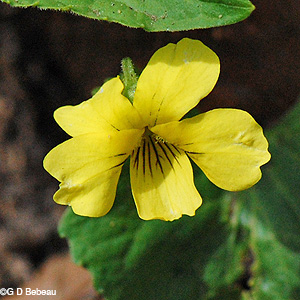
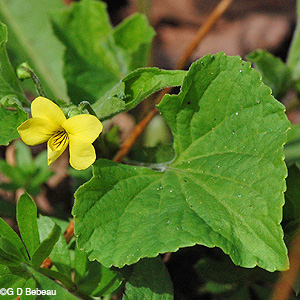
Above: 1st photo - The two side petals are bearded. All 5 have the purplish-brown vein lines which act as nectar guides. 2nd photo - One of the upper stem leaves.
Below: 1st photo - The green sepals have linear long-pointed tips. 2nd photo - The flower stem has downy hair and makes a 90 degree angle at the top causing the flower to face outward.
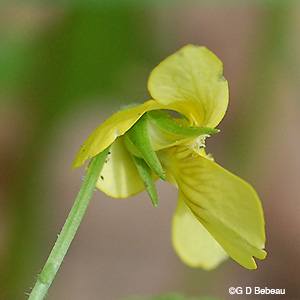
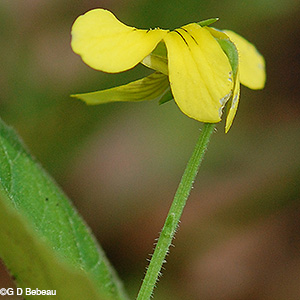
Below: 1st photo - A basal leaf, which has similar teeth to the stem leaf, but is more rounded in shape. 2nd photo - The underside of the leaf has prominent veins, downy hair and at the base of the stalk are a pair of large ovate stipules.
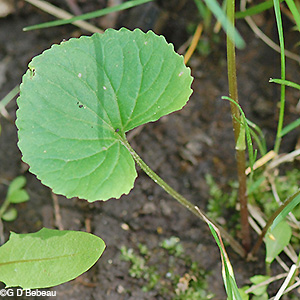
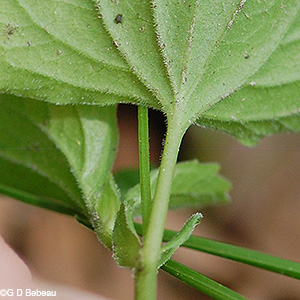
Below:s Seed capsules - one open with its three outstretched arms and one about to open.

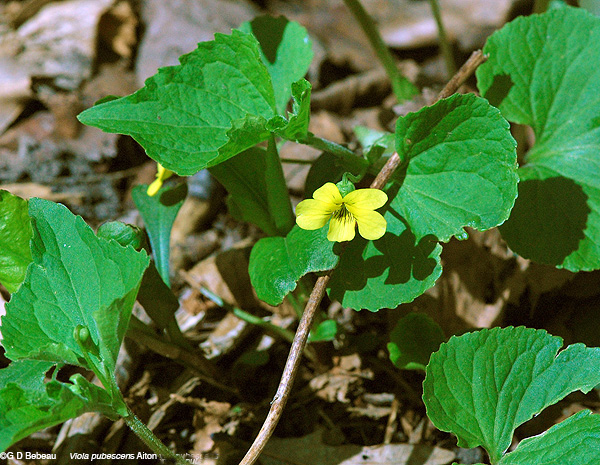
Notes: Downy Yellow Violet is indigenous to the Garden area. Eloise Butler catalogued it on May 31, 1907. In addition, she obtained plants on April 25, 1915 from a woods along Superior Blvd. in Minneapolis. She also obtained plants from Groveland Park in St. Paul in various later years and from Glenwood Park in 1918 to plant around her new bird bath. She specifically listed planting var. scabriuscula in 1922 and 1931. Martha Crone added plants in 1946. In 1953 she added plants she called var. eriocarpa [eriocarpon], but that variety is no longer accepted as separate and is now considered the same as var. pubescens.
Downy Yellow Violet, like the Common Blue Violet is native to most Minnesota Counties and will usually appear, sooner or later, in most back-yard gardens. Although both varieties of the species occur in Minnesota, the DNR does not segregate it it's county plant survey. It is one of 21 native violets found in the State. In the U.S. and Canada the plant is found from the Great Plains eastward. Eloise Butler wrote extensively about violets - Read her notes.
Wm. Cullen Bryant wrote a poem - The Yellow Violet
Return to -- Site Plan/Archive Index --or-- List of Common Plant Names -- or -- List of Scientific Names -- or --Home Page - - - Back to top.
References: Plant characteristics are generally from sources 1A, 32, W2, W3, W7 & W8 plus others as specifically applied. Distribution principally from W1, W2 and 28C. Planting history generally from 1, 4 & 4a. Other sources by specific reference. See Reference List for details.
 Identification booklet for most of the flowering forbs and small flowering shrubs of the Eloise Butler Wildflower Garden. Details Here.
Identification booklet for most of the flowering forbs and small flowering shrubs of the Eloise Butler Wildflower Garden. Details Here.
©2013
Friends of the Wildflower Garden, Inc. Text and photos are by G. D. Bebeau unless otherwise credited. "www.friendsofeloisebutler.org"
032620